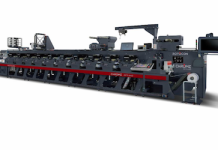High Laydown Technology is now available for printing a range of textured effects on labels, folding cartons and products. Such high-build, textured effects (also called tactile or dimensional effects) can be used to significantly enhance the shelf appeal of products and ensure that they stand out when on display.
Additionally, Xaar is announcing the extension of its Xaar 2001+ high performance print head family to include UV applications such as printing labels and cartons.
High Laydown (HL) is a unique technology that adds to Xaar’s range of deposition technologies and enhances Xaar’s growing Intellectual Property portfolio. When incorporated into the Xaar 1003 and Xaar 2001+ print heads, it can be used to print very high levels of UV clear varnish, even at high speed. The Xaar 1003 GS12U can print an 80 micron layer thickness at 25 m/min line speed, or a 50 micron layer at 50 m/min, in a single pass, thereby building in texture as part of the print process.
Texture provides a raised effect that transforms standard labels and folding cartons into high-value packaging for products that can command a premium. A recent InfoTrends study (CMYK: The Use of Special Effects in Digital Printing) found that print buyers are willing to pay up to 89% more for textured effects compared to standard CMYK-only work. As well as adding texture as part of the print process, Xaar’s HL Technology can be used for producing raised foil effects for extra impact. Tactile information effects such as warning triangles required on hazardous products and Braille can also be created without the need for an additional print stage or process.
Overall, digital technology provides a compelling alternative to rotary screen techniques commonly used for printing textured labels. Digital print avoids the need for custom rotary screens, which can be time-consuming and costly to produce, as well as often needing to be outsourced to specialist suppliers. Removing this requirement means that adding texture is now within reach for short and medium label runs using HL Technology; previously rotary screen techniques may have been too expensive to offer this feature.
Similarly, while other digital alternatives typically require multiple print bars to build up sufficient layer thickness, or machines to run at low speeds, the textured effects can be created easily with a single print bar running at a reasonable production speed with HL Technology.
Separately, the Xaar 2001+ family, announced in 2016 for ceramics applications, has been extended for UV print applications. This high-performance print head optimises production output with exceptional print quality at high line speed.
The Xaar 2001+ incorporates multiple technologies unique to Xaar to ensure continuous and reliable printing in single-pass operation, maximising production output, minimising production interruptions and reducing the need for operator intervention. This development, combined with Xaar’s HL Technology, means that the Xaar 2001+ GS12U can achieve unprecedented laydown levels for tactile effects.
‘HL Technology adds a new capability to this very successful product range,’ commented Gerard Winn, senior product manager at Xaar. ‘With minimal work, OEMs can upgrade their existing presses to incorporate the latest technology, and make textured labels and folding cartons much more accessible and affordable for print shops and therefore for their customers too.’





















